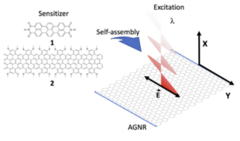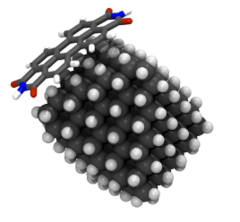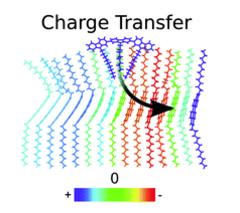Dr. Carlos Raul Medrano

|
Research

Complex van der Waals heterostructures from layered molecular stacks might offer means to efficient optoelectronics, due to adjustable photoactive, charge separation and collection layers. Self-assembled monolayers can be employed as modular dopants for precisely tunable absorption, emission or charge separation. Here we find that optical excita-tions of self-assembled monolayers on graphene ribbons mix, resulting in interlayer exciton formation and corre-sponding absorption suppression or enhancement. Time-dependent density functional tight binding reveals nonlinear interlayer exciton dissociation without recombination in rylene acceptors and cove graphene nano-ribbon donors on top of armchair graphene platforms. Our results have important implications in van der Waals pho-tovoltaics, field-driven lasing and related nonlinear optics.
Trap-door-like Irreversible photoinduced charge transfer in a DA-Complex

For efficient conversion of light into useful energy sources, it is very important to study and describe the first steps of primary charge-transfer process in natural structures and artificial devices. The time scale of these processes in artificial photosynthetic and photovoltaic devices is on the order of femto- to picoseconds and involves vibronic coupling of electrons and nuclei and also nuclear alleviation to enhance charge separation. Here we present an atomistic description of the photoexcited electron dynamics in a noncovalently bonded system formed by an hydrogenated nanodiamond as donor and a perylene diimide as an acceptor. The complex shows extremely fast charge transfer, separation, and stabilization within 90 fs. This stabilization is purely electronic in nature. To the best of our knowledge, these results show for the first time that it is possible to stabilize charge without polaron formation or nuclear relaxation, reaching a steady state enhanced by a pure electronic reorganization.
Photoinduced charge-transfer dynamics simulations in noncovalently bonded molecular aggregates

The rational design of new materials as prototype systems for organic solar cells remains challenging. Perylene diimide has emerged as a promising material to replace fullerene derivatives because of its synthetic flexibility, leading to the manipulation of their optical properties. As a result of their fused aromatic core that favors p–p stacking interactions, the aggregation of these molecules can reach highly ordered nanostructures as one-dimensional nanofibers, with a fast photoinduced charge transfer mechanism. In this article, we present an atomistic description of the photoexcited exciton dynamics in noncovalently bonded perylene diimides by time integration of the electron density in the presence of external time varying electric fields. We show that our approach is able to capture and explain the physics that underlies the charge transport mechanism through perylene diimide aggregates.
